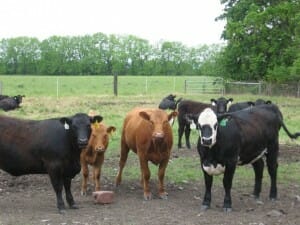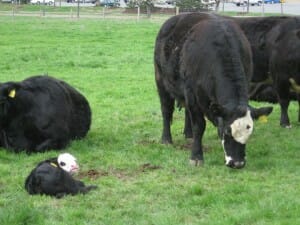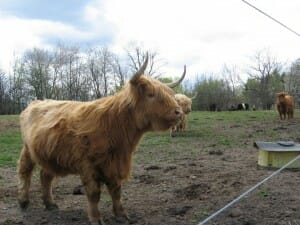Over-Herd on the PFI Listserve: AI, a question of genetic availability, and effects
The grazing listserve exploded with activity following a query by member Wade Dooley last week. Looking to try something different on his farm, Wade asked others about their experiences with breeding beef heifers by AI, and about which traits to look for.
Some of the interesting points brought up:
What are the goals of the producer? This influences both the decision to AI, and the decision of which bulls to utilize.
- Compared to bull breeding, AI has unique costs and labor requirements, but can be more conducive to synchronization of animals, introduces new genetics, and eliminates disease risk of purchasing bulls.
- Bull breeding is more successful (particularly in heifers) and is lower-labor than AI, but requires keeping another animal on the farm, or finding one somewhere. Unless linebreeding is a goal or an option, it also requires purchasing a new bull every few years.
What sort of offspring is the producer looking for? Producers need to consider their market and their goals before selecting a bull, either on the hoof or in the tank.
- Are the offspring going to be retained or are they going to be sold for beef?
- How are those offspring going to be managed; on grass or on grain?
These questions will determine a lot of things. Calves that a producer wants to keep or sell as breeding stock (mostly females) need to be able to perform in his system (or that of his customer). If management is low-input and forage-based, smaller frame-sized cows are often recommended for their lower maintenance feed requirements. If supplemental concentrates or high-energy feeds are to be offered, a larger cow or one with greater milking ability is more likely to wean a larger calf.
If the calves are to be finished and sold for beef, the management system also influences bull choice. Smaller-framed cattle will finish at a lower weight, thus requiring less time and feed before finishing. If the calves are destined for a feedlot or will be fed supplements, as with the cows, a larger animal can be sustained.
So now, some more thoughts and questions emerge.
- Which breed? There are plenty out there. Some are notorious for marbling, efficiency, tenderness, grass-friendliness, and so on. While keeping within a breed increases the marketability of purebred stock, crossbreeding can improve offspring growth and performance through heterosis. EPDs (Expected Progeny Differences) are values that (mostly within a breed) allow comparison of bulls. For instance, a bull with a birth weight EPD of +5 will produce calves that – on average – weigh 5 lb more at birth than the calves of a bull with a birth weight EPD of 0. EPDs can be used to find bulls fitting whatever niche is desired.
- Which sire?
- For terminal calves: many producers look for bulls with low birth weight EPDs (which contributes to calving ease, particularly important for heifers) but higher weaning weight EPDs (so the calves start small but grow big).
- For female production: producers might opt for more moderate birth and weaning weights, or might simply focus on maternal calving ease, maternal milk production, and stayability.
Some of the specific advice gleaned from the listserve discussion follows.
- Erik Cleveland asked whether anyone had tried Native Shorthorns, known for small frame size and good marbling; as well as Devons, Red Polls, and British Whites.
- Several producers, including Tom McDermott, Ryan Herman, and Lorraine Stevens, mentioned Kit Pharo and his Angus line known for small frame size and grass-finishing ability.
- Ron Dunphy brought up testing of cattle for efficiency, and recommended the Hereford breed. He also referenced Craig Hayes, who operates a feedlot and tests for feed efficiency.
- On a similar vein, Doug Wirth suggested Hawkeye Breeders, a bull housing and collection facility. He also recommended Iowa State Extnsion as a resource.
- Ryan Herman pointed out that cow size does influence calf size, but that with the right management and genetic selection, a smaller frame-size cow can produce a similarly-sized calf. He also provided some scenarios that would influence whether large or small cows and calves would be desirable.
- Lorraine Stevens had some specific bulls that she has included in her bloodlines, notably a bull out of Gerald Fry’s herd, Kissimmee. She has bred one of his sons to Maine Anjous and is pleased with the results.
- Joe Sellers pointed out that while the growth EPDs are mostly based on feedlot data, rather than forage-finishing, the maternal traits are often grass-based. Some breeds, he says, have indices that estimate cows’ energy requirements. Traits that made his list of considerations included marbling and fat thickness, percent retail product, stayability, frame size, yearling and mature weight, and maternal milk. He suggested F1 or composite bulls as a good way to keep the heterosis advantage in an already-mixed herd.
- Jacob Myers seconded the need to first consider the calves’ ultimate fate (breeding or beef), and provided some insight on the costs of AI. Cattle companies he recommended were Ohlde Cattle Company, Diamond D Angus, and 5L Red Angus.
- Dave Schmidt will be the proud “parent” of some AI calves soon, hopefully to be replacement females. He selected Beckton Stock Farm Red Angus sires for low birthweight, low maintenance, moderate milk, and high stayability.
- Margaret Dunn summarized some of the justifications for cattle of different mature sizes based on production goals and management, and provided links to EPD databases for Red Angus, Simmentals, and Limousins.
- Andy Johnson, in a typical practical farmer fashion, brought up that the physical handling of smaller cattle can be easier, particularly when facilities are limited. He also asked about a PFI bull exchange, noting that the relatively small number of cattle producers anymore make it difficult to get quick access to new blood.
- Kevin Dietzel asked about comparing EPDs within breeds and across years, as some are calculated based on the breed average (rather than a national average). Joe Sellers responded with links to EPD comparisons between breeds and the cross-breed means.
- And in classic PFI style…the discussion ended with a joke, thanks to Grant Schultz.
Practical Farmer #1: “I was able to reduce my average frame size and nearly double feed efficiency in under a year by using some purchased genetics”
Practical Farmer #2: “Whoa! What did you do?”
Practical Farmer #1: “I sold all my cows and bought sheep.”
Links of interest:
- Across-breed EPD table: http://www.beefimprovement.org/PDFs/2012/Across-Breed-EPD-Factors.pdf
- Mean EPDs reported by different breeds: http://www.beefimprovement.org/PDFs/2012/BreedAverages-EPD.pdf
- National Beef Cattle Evaluation Consortium: http://www.nbcec.org/producers.html
Anyone interested in being forwarded the conversation or getting onto the grazing listserve should contact Margaret (Margaret@practicalfarmers.org).



